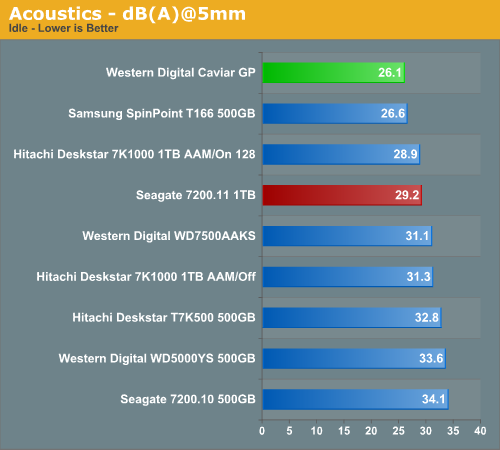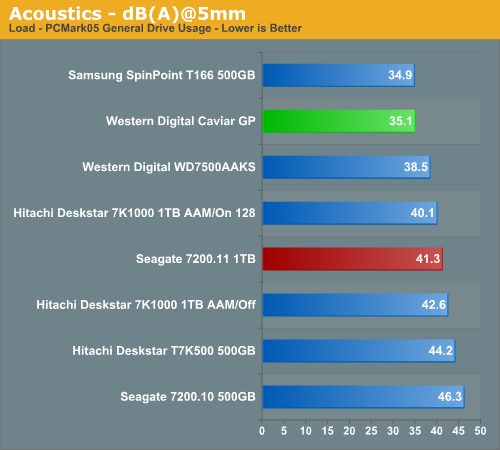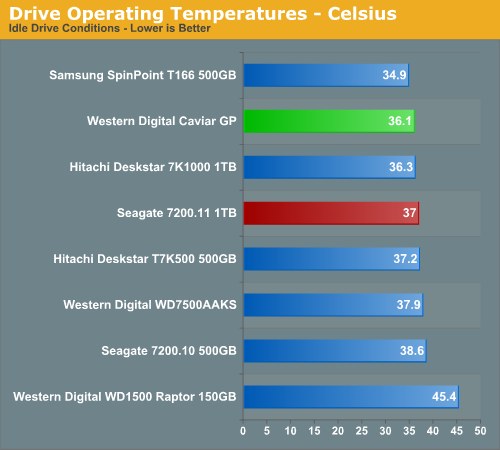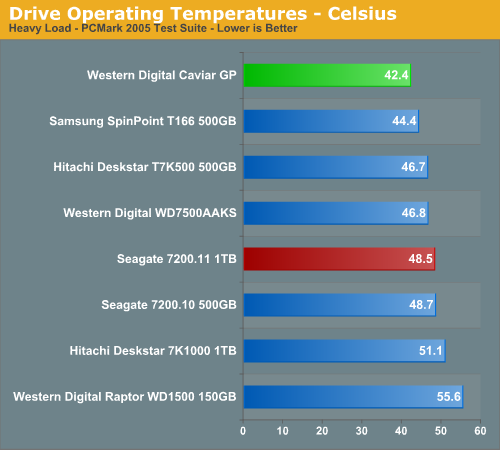Seagate and Western Digital 1TB Drives: Improved and Green
by Dave Robinet on November 26, 2007 7:00 AM EST- Posted in
- Storage
Acoustics
Our test methodology for acoustics has changed. Rather than checking the drive inside the case with components, we use an external USB-SATA converter cable to run the drive to a different physical room to take our measurements. While the conversion to USB does reduce the performance level of the drive during the test, it leaves the noise characteristics unchanged. The drive sits atop a small brick of acoustical sponge material to keep it raised from the floor without introducing additional vibration. We take measurements at a distance of 5mm from the rear and front of the drive. These precautions, whose results on earlier drives confirm the accuracy of our previous methodology, will further reduce the likelihood of ambient noise from the PC interfering with our results.
Our acoustic tests measure the decibel levels while the system is at idle and under load while running the General Hard Disk Drive Usage benchmark within PCMark 2005. We found through trial and error that this particular benchmark produces controlled readings across a wide range of applications within the benchmark. This particular benchmark utilizes 60% reads and 40% writes within the trace playback file.
We report measurements based on an A-weighted decibel score that measures frequencies similar to the way the human ear responds to sound. We take three measurements for each test. We then subtract the high and low scores and arrive at our findings by reporting the remaining score. The test room has a base acoustical level of 20dB(A).


The idle noise level of the Caviar GP is impressive, owing to the lower rotational speed of the drive due to its power saving technology. At load, however, the drive is slightly louder than the Samsung T166. The Seagate 7200.11 drive turns in middling results in both tests.
Thermals
Our thermal tests utilize sensor readings via the S.M.A.R.T. (Self-Monitoring, Analysis and Reporting Technology) capability of the drives as reported by utilizing the Active SMART 2.6 utility. We also utilize thermal sensors and infrared measurement devices to verify our utility results. We test our drives in an enclosed case environment without the fans operational to simulate temperatures that conceivably exists in a near-silent SFF or HTPC case design. We typically find the reported numbers drop anywhere from 14% to 25% with the case fans operational. Our base temperature level in the room at the time of testing is 25C.


Here is where we see the Caviar GP shine. The temperature reading of 42.4C under load is the coolest conventional drive we have tested, coming in even cooler than the Samsung T166. The Seagate 7200.11 produces comparatively little heat at idle, but warms quickly under load, finishing near the hottest drives we have tested.










31 Comments
View All Comments
Luminair - Tuesday, November 27, 2007 - link
"Operating System Stated Capacity"Lets be clear so maybe you can be clear in the next article.
The IEC, IEEE, CPIM, and NIST define Giga (G) as 1,000,000,000 or one billion.
The same standards organizations define Gibi (Gi) as 1,073,741,824.
As such, by standard definitions, these hard drives are in fact 1000GB, or 1000 gigabytes.
Your "Operating System Stated Capacity" really means "Windows Explorer Capacity". Other operating systems don't get it wrong like Windows does. So if you report this wrong information at all, you should make the truth known -- that Windows is well known to WRONGLY report GiB as GB (and MiB for MB and so on).
Those drives have 1000 gigabytes of space. Windows Explorer and solid state memory companies report the space incorrectly.
Luminair - Friday, November 30, 2007 - link
These guys get it right :) http://www.pcgameshardware.de/?menu=browser&ar...">http://www.pcgameshardware.de/?menu=bro...&ima...valherumk2 - Tuesday, November 27, 2007 - link
Looks like another review of the 7200.11 drive where it appears the reviewer didn't remove the jumper limiting it to SATA 1. Interface bandwidth burst rate is over 200MB/s on my 7200.11 with the jumper removed.Zap - Thursday, November 29, 2007 - link
That's also the first thing that came to my mine... "dude forgot to remove the jumper."Zap - Thursday, November 29, 2007 - link
That's also the first thing that came to my mine... "dude forgot to remove the jumper."100proof - Monday, November 26, 2007 - link
Dave, is there a reason that Samsung's 1TB drivewas not included in this review? The drive is
difficult to obtain in the US but is available in
other countries at this point in time. Tomshardware
has already posted a review, and there is also
discussion taking place on storagereview.com
Tomshardware Review of Samsung F1 1TB
http://www.tomshardware.com/2007/11/21/samsung_ove...">http://www.tomshardware.com/2007/11/21/samsung_ove...
Storagereview discussion of F1 Series
http://forums.storagereview.net/index.php?showtopi...">http://forums.storagereview.net/index.php?showtopi...
Dave Robinet - Tuesday, November 27, 2007 - link
It's a matter of availability, not of lack of interest. We do like the latest Samsung offerings - they simply didn't have a drive shipped to us in the lab in time for the article.If they get us a 1TB drive for us to have a look at, then we'll gladly put it in a future article.
Thanks for reading!
quanta - Wednesday, November 28, 2007 - link
In the meantime, Tom's hardware did the Samsung Spinpoint F1 review[1], which showed it has great non-server performance. In fact, it outruns WD Raptor WD150ADFD in some tests. Power consumption is between 'cuda 7200.11 and Caviar GP.[1] http://www.tomshardware.com/2007/11/21/samsung_ove...">http://www.tomshardware.com/2007/11/21/samsung_ove...
piasabird - Monday, November 26, 2007 - link
You get a lower overall price per Gig by using two 500 gb drives.Googer - Monday, November 26, 2007 - link
With a pair of 500GB hard drives, you do not get it in a single volume, power consumption increases, RAID 0 decreases reliability and increases error possibilities.The fact that it takes two drive bays is a sore thumb to those who build small form factor multi-media systems with only one drive bay that will also funtion as a Digtal Video Recorder.
I should also add, this "GREEN" drive is ideal for a TiVO upgrade due to it's large size, quiet operation, low heat, and noise output.